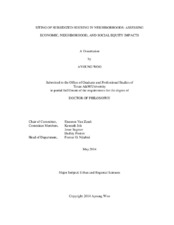| dc.contributor.advisor | Van Zandt, Shannon | |
| dc.creator | Woo, Ayoung | |
| dc.date.accessioned | 2015-01-09T20:28:50Z | |
| dc.date.available | 2016-05-01T05:30:55Z | |
| dc.date.created | 2014-05 | |
| dc.date.issued | 2014-04-23 | |
| dc.date.submitted | May 2014 | |
| dc.identifier.uri | https://hdl.handle.net/1969.1/152713 | |
| dc.description.abstract | Although the Low-Income Housing Tax Credit (LIHTC) program has grown into
the largest subsidized housing program in the U.S., we have limited understanding about
the performance of the program. This study explores the associations between LIHTC
subsidized households and uneven geography of opportunities in the cities of Charlotte,
North Carolina, and Cleveland, Ohio, to identify socioeconomic inequalities for
subsidized households using a variety of methods. First, the dissertation employs the
simple bivariate analysis, in terms of a location quotient (LQ), to examine the empirical
evidence on inequitable opportunities. Based on the results of location quotients, this
study suggests that current patterns of LIHTC developments may perpetuate inequitable
opportunities for subsidized households through pushing them into the vicious circle of
residential segregation and inequality.
This paper also explores impacts of the LIHTC program on nearby property
values and neighborhood stability to contextualize the economic and neighborhood
impacts of the program. To be more specific, this dissertation examined housing prices
and housing turnover before and after the introduction of LIHTC developments into the
neighborhood, based on housing sales data from 1996 to 2007. This data is merged with
parcel-level data from Mecklenburg and Cuyahoga County. The study estimates an
AITS-DID (Adjusted Interrupted Time Series-Difference in Differences) and an
extended Cox hazard model with the difference-in-differences specification to clarify the
direction of causality in the impacts of LIHTC developments. This research also
explores impacts on neighboring housing prices and neighborhood stability from LIHTC developments citywide and in neighborhoods stratified by income.
When it comes to estimating the relationships between the developments of LIHTC subsidized housing and surrounding housing prices, this study found that impacts of LIHTC developments varied across different housing market conditions (i.e., a “hot” and a “cold” market). The LIHTC developments had a negative impact on nearby property values in Charlotte while they had a positive impact in Cleveland. These results suggest that the LIHTC program may be implemented to revitalize or stimulate deteriorated areas, especially in depressed housing market conditions. In terms of examining the associations between the LIHTC developments and neighborhood stability, this study found significant negative impacts on stability of LIHTC developments in both cities, and the probability of housing turnover was significantly higher when LIHTC units were developed within the immediate neighborhood of each property. However, for the high-income submarket, there were strong spillover effects in Charlotte while there were no significant impacts in Cleveland. These results suggest that the vulnerability of neighborhood stability due to LIHTC development needs to be considered when implementing a successful subsidized housing program. | en |
| dc.format.mimetype | application/pdf | |
| dc.language.iso | en | |
| dc.subject | Siting of Subsidized Housing in Neighborhoods: Assessing Economic, Neighborhood, and Social Equity Impacts | en |
| dc.title | Siting of Subsidized Housing in Neighborhoods: Assessing Economic, Neighborhood, and Social Equity Impacts | en |
| dc.type | Thesis | en |
| thesis.degree.department | Landscape Architecture and Urban Planning | en |
| thesis.degree.discipline | Urban and Regional Sciences | en |
| thesis.degree.grantor | Texas A & M University | en |
| thesis.degree.name | Doctor of Philosophy | en |
| thesis.degree.level | Doctoral | en |
| dc.contributor.committeeMember | Joh, Kenneth | |
| dc.contributor.committeeMember | Saginor, Jesse | |
| dc.contributor.committeeMember | Poston, Dudley | |
| dc.type.material | text | en |
| dc.date.updated | 2015-01-09T20:28:50Z | |
| local.embargo.terms | 2016-05-01 | |
| local.etdauthor.orcid | 0000-0002-6066-0962 | |


